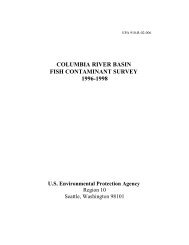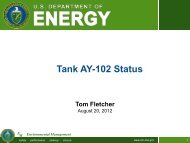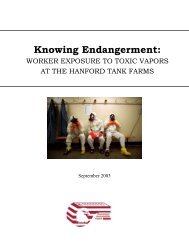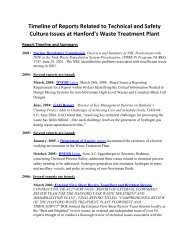Reducing the Risks of High-Level Radioactive Wastes at Hanford
Reducing the Risks of High-Level Radioactive Wastes at Hanford
Reducing the Risks of High-Level Radioactive Wastes at Hanford
You also want an ePaper? Increase the reach of your titles
YUMPU automatically turns print PDFs into web optimized ePapers that Google loves.
52 Alvarez<br />
Figure 3: Double-Shell Tank. (Source: Pacific Northwest N<strong>at</strong>ional Labor<strong>at</strong>ory.)<br />
clustered in 12 “Tank Farms.” No wastes have been added to <strong>the</strong> SSTs since<br />
1980. Of <strong>the</strong>se, 67 tanks are estim<strong>at</strong>ed to have leaked over 1 million gallons. 27<br />
The single-shell tanks store about 132,500 cubic meters <strong>of</strong> saltcake, sludge,<br />
and liquid containing 110 million curies <strong>of</strong> radioactivity. 28 About 90 percent<br />
<strong>of</strong> SST wastes are sodium nitr<strong>at</strong>es and nitrites. About 75 percent <strong>of</strong> <strong>the</strong><br />
radioactivity in <strong>the</strong>se tanks comes from strontium-90 concentr<strong>at</strong>ed in sludge<br />
and 24 percent from cesium-137 in soluble liquids and saltcake.<br />
Double-Shell Tanks—Between 1968 and 1986, 28 tanks with double steel<br />
liners, were constructed with a capacity <strong>of</strong> 1 to 1.16 million gallons. They<br />
contain about 83,279 cubic meters or 23 million gallons <strong>of</strong> mostly liquids<br />
(∼80 percent), as well as sludges and salts. 29 The estim<strong>at</strong>ed amount <strong>of</strong><br />
radioactivity in <strong>the</strong> DSTs is about 80 million curies (Cs-137 = 72 percent<br />
and Sr-90 = 27 percent). 30 As in single-shell tanks, wastes are primarily<br />
composed <strong>of</strong> sodium salts, and also have additional metal hydroxides, phosph<strong>at</strong>es,<br />
carbon<strong>at</strong>es and sulf<strong>at</strong>es. None <strong>of</strong> <strong>the</strong> DSTs has leaked, but <strong>at</strong> least<br />
one has experienced major corrosion problems. 31 A technical basis for controlling<br />
corrosion <strong>of</strong> double–shell tanks through chemistry controls has thus<br />
far proven illusive. 32<br />
CONSEQUENCES OF THE PRODUCTION IMPERATIVE<br />
Efforts to keep waste storage expenses down during <strong>the</strong> period <strong>of</strong> nuclear<br />
weapons production, cre<strong>at</strong>ed significant problems. Approxim<strong>at</strong>ely 120<br />
to 130 million gallons <strong>of</strong> high-level wastes were discharged to <strong>the</strong> ground. 33<br />
<strong>Wastes</strong> were transferred extensively, between tanks, without adequ<strong>at</strong>e







